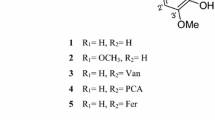Abstract
The composition of the volatile oil from Lithospermi Radix, the dried roots of Lithospermum erythrorhizon (Boraginaceae), has been investigated by capillary GC and GC–MS. To investigate the anti-inflammatory activity of the oil, in-vitro inhibition of ovine cyclooxygenase-1 and 2 (COX-1 and COX-2) activity by the oil was studied. Fifty-four components of the oil were identified, representing 92.74% of the oil. The main components were 2-methylbutanoic acid (21.50%), 3-methylbutanoic acid (12.61%), 2-methylpropanoic acid (8.99%), methyl linoleate (8.76%), methyl oleate (6.27%), methyl palmitate (6.06%), and 2-methyl-2-butenoic acid (5.74%). Highly selective COX-2 inhibition was observed; at 50 μg/ml the oil inhibited 38.8% of COX-2 activity.


Similar content being viewed by others
References
Kapoor M, Shaw O, Appleton I (2005) Possible anti-inflammatory role of COX-2-derived prostaglandins: implications for inflammation research. Curr Opin Investig Drugs (Thomson Scientific) 6:461–466
Namba T (1980) Coloured illustrations of wakan-yaku. Hoikusya publishing Co. Ltd., Hoikusya
Morimoto I, Kishi T, Ikegami S, Hirata Y (1965) Naphthoquinone derivatives from Lithospermum erythrorhizon. Tetrahedron Lett 4737–4739
Morimoto I, Hirata Y (1966) Naphthoquinone derivatives from Lithospermum erythrorhizon. Tetrahedron Lett 3677–3680
Kyogoku K, Terayama H, Tachi Y, Suzuki T, Komatsu M (1973) Constituents of shikon I. Structure of three new shikonin derivatives and isolation of anhydroalkannin. Shoyakugaku Zasshi 27:24–30
Kyogoku K, Terayama H, Tachi Y, Suzuki T, Komatsu M (1973) Constituents of shikon II. Comparison of contents, constituents, and antibacterial effect of fat soluble fraction between nanshikon and kosikon. Shoyakugaku Zasshi 27:31–36
Hisamichi S, Yoshizaki F (1982) Studies on the shikon I. Structures of new minor pigments and isolation of two isomers of shikonin derivatives from Lithospermum erythrorhizon Sieb. et Zucc. Shoyakugaku Zasshi 36:154–159
Hashimoto S, Xu Y, Masuda Y, Aiuchi T, Nakajo S, Uehara Y, Shibuya M, Yamori T, Nakaya K (2002) β-Hydroxyisovalerylshikonin is a novel and potent inhibitor of protein tyrosine kinases. J Cancer Res 93:944–951
Wang WJ, Bai JY, Liu DP, Xue LM, Zhu XY (1994) The antiinflammatory activity of shikonin and its inhibitory effect on leukotriene B4 biosynthesis. Yaoxue Xuebao 29:161–165
Chen X, Oppenheim J, Howard OMZ (2001) Shikonin, a component of antiinflammatory Chinese herbal medicine, selectively blocks chemokine binding to CC chemokine receptor-1. Int Immunopharmacol 1:229–236
Wang JP, Raung SL, Chang LC, Kuo SC (1995) Inhibition of hind-paw edema and cutaneous vascular plasma extravasation in mice by acetylshikonin. Eur J Pharmacol 272:87–95
Subbaramaiah K, Bulic P, Lin Y, Dannenberg AJ, Pasco DS (2001) Development and use of a gene promoter-based screen to identify novel inhibitors of cyclooxygenase-2 transcription. J Biomol Screen 6:101–110
Staniforth V, Wang SY, Shyur LF, Yang NS (2004) Shikonins, phytocompounds from Lithospermum erythrorhizon, inhibit the transcriptional activation of human tumor necrosis factor alpha promoter in vivo. J Biol Chem 279:5877–5885
Adams RP (2001) Identification of essential oil components by gas chromatography/quadrupole mass spectroscopy. Academic Press, New York
Miura S (1963) Crude fat in the root of Japanese Lithospermum. Shoyakugaku Zasshi 17:45–49
Jennifer LJ, Jeffrey W, Scott DB, Richard DD, Krishna RM (1995) Purification and characterization of prostaglandin H synthase-2 from sheep placental cotyledons. Arch Biochem Biophys 324:26–34
Kim RG, Shin KM, Chun SK, Ji SY, Seo SH, Park HJ, Choi J, Lee KT (2002) In vitro antiinflammatory activity of the essential oil from Ligularia fischeri var. spiciformis in murine macrophage raw 264.7 cells. Yakhak Hoechi 46:343–347
Passos GF, Fernandes ES, Cunha FM, Ferreira J, Pianowski LF, Campos MM, Calixto JB (2007) Anti-inflammatory and anti-allergic properties of the essential oil and active compounds from Cordia verbenacea. J Ethnopharmacol 110:323–333
Peana AT, Marzocco S, Popolo A, Pinto A (2006) (−)-Linalool inhibits in vitro NO formation: probable involvement in the antinociceptive activity of this monoterpene compound. Life Sci 78:718–723
Acknowledgments
This work was supported by Grant-in-Aid from the Japan Society for the Promotion of Science (No. 19300244), and a grant from Ministry of Education, Culture, Sports, Science and Technology for the “High-Tech Research Center” project for Private Universities, 2004–2008.
Author information
Authors and Affiliations
Corresponding author
Rights and permissions
About this article
Cite this article
Kawata, J., Kameda, M. & Miyazawa, M. Cyclooxygenase-2 inhibitory effects and composition of the volatile oil from the dried roots of Lithospermum erythrorhizon . J Nat Med 62, 239–243 (2008). https://doi.org/10.1007/s11418-007-0221-0
Received:
Accepted:
Published:
Issue Date:
DOI: https://doi.org/10.1007/s11418-007-0221-0




